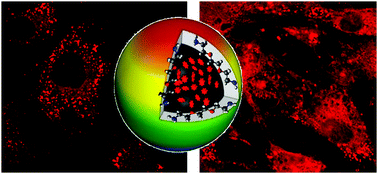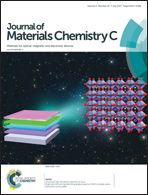Host–guest carbon dots as high-performance fluorescence probes†
Abstract
Host–guest carbon dots (G@CDots) represent a new platform in the rapidly advancing and expanding research field of carbon “quantum” dots or carbon dots, enabling the development of novel carbon hybrid nanostructures of unique and/or advantageous properties and capabilities beyond those of conventional carbon dots. In this study, the red/near-IR emissive dye nile blue (NB) was selected as the guest, and NB@CDots were prepared in a microwave-assisted one-pot thermal carbonization synthesis with oligomeric polyethylene glycols (PEGs) as the precursor and also surface passivation species in the resulting host–guest dots. The NB@CDots exhibited unique and/or favorable characteristics, including especially the bright red/near-IR fluorescence emissions, with the observed fluorescence quantum yield due to the guest nile blue species more than an order of magnitude higher than that of free nile blue molecules, all in aqueous solutions. The higher fluorescence intensities were coupled with a longer fluorescence lifetime, and also accompanied by excellent photochemical stability, making the NB@CDots high-performance fluorescence probes for bioimaging-sensing and related applications. Indeed, their potential in this regard was explored and demonstrated in the fluorescence imaging of live stem cells. The NB@CDots were also evaluated in cytotoxicity assays, and the results suggested their being nontoxic. Excellent opportunities in further development of the host–guest carbon dots platform for high-performance yet nontoxic fluorescence probes are discussed.



 Please wait while we load your content...
Please wait while we load your content...